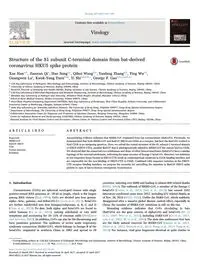
2017 Structure of the S1 subunit C-terminal domain from bat-derived coronavirus HKU5 spike protein PDF
Preview 2017 Structure of the S1 subunit C-terminal domain from bat-derived coronavirus HKU5 spike protein
Contents lists available at ScienceDirect Virology journal homepage: www.elsevier.com/locate/yviro Structure of the S1 subunit C-terminal domain from bat-derived coronavirus HKU5 spike protein Xue Hana,b, Jianxun Qia, Hao Songa,c, Qihui Wangd,e, Yanfang Zhanga,b, Ying Wue,f, Guangwen Lug, Kwok-Yung Yuenh,i,j, Yi Shia,b,e,k,⁎, George F. Gaoa,b,c,e,j,k,l,⁎ a CAS Key Laboratory of Pathogenic Microbiology and Immunology, Institute of Microbiology, Chinese Academy of Sciences, Beijing 100101, China b University of Chinese Academy of Sciences, Beijing 100049, China c Research Network of Immunity and Health (RNIH), Beijing Institutes of Life Science, Chinese Academy of Sciences, Beijing 100101, China d CAS Key Laboratory of Microbial Physiological and Metabolic Engineering, Institute of Microbiology, Chinese Academy of Sciences, Beijing 100101, China e Shenzhen Key Laboratory of Pathogen and Immunity, Shenzhen Third People's Hospital, Shenzhen 518112, China f School of Basic Medical Sciences, Wuhan University, Wuhan 430071, China g West China Hospital Emergency Department (WCHED), State Key Laboratory of Biotherapy, West China Hospital, Sichuan University, and Collaborative Innovation Center of Biotherapy, Chengdu, Sichuan 610041, China h State Key Laboratory for Emerging Infectious Diseases, The University of Hong Kong, Pokfulam 999077, Hong Kong Special Administration Region i Department of Microbiology, The University of Hong Kong, Pokfulam 999077, Hong Kong Special Administration Region j Collaborative Innovation Center for Diagnosis and Treatment of Infectious Diseases, Zhejiang University, Hangzhou 310003, China k Center for Influenza Research and Early-warning (CASCIRE), Chinese Academy of Sciences, Beijing 100101, China l National Institute for Viral Disease Control and Prevention, Chinese Center for Disease Control and Prevention (China CDC), Beijing 102206, China A R T I C L E I N F O Keywords: MERS-CoV BatCoV HKU5 CTD Crystal structure Evolution A B S T R A C T Accumulating evidence indicates that MERS-CoV originated from bat coronaviruses (BatCoVs). Previously, we demonstrated that both MERS-CoV and BatCoV HKU4 use CD26 as a receptor, but how the BatCoVs evolved to bind CD26 is an intriguing question. Here, we solved the crystal structure of the S1 subunit C-terminal domain of HKU5 (HKU5-CTD), another BatCoV that is phylogenetically related to MERS-CoV but cannot bind to CD26. We observed that the conserved core subdomain and those of other betacoronaviruses (betaCoVs) have a similar topology of the external subdomain, indicating the same ancestor of lineage C betaCoVs. However, two deletions in two respective loops located in HKU5-CTD result in conformational variations in CD26-binding interface and are responsible for the non-binding of HKU5-CTD to CD26. Combined with sequence variation in the HKU5- CTD receptor binding interface, we propose the necessity for surveilling the mutation in BatCoV HKU5 spike protein in case of bat-to-human interspecies transmission. 1. Introduction Coronaviruses (CoVs) are spherical enveloped viruses with single positive-strand RNA genomes of ~30 kb in length, which is the largest among RNA viruses (Saif, 1993). CoVs are divided into four genera: alpha-, beta-, gamma-, and deltaCoVs (de Groot et al., 2013). BetaCoVs are further subdivided into four lineages/subgroups: A, B, C, and D (Chan et al., 2015). To date, both alpha- and betaCoVs are found to infect humans (Lu et al., 2015), causing subclinical or very mild symptoms and accounting for 10–15% of common colds (Heikkinen and Jarvinen, 2003). In addition, CoVs can also be life-threatening and have pandemic potential. The epidemic of severe acute respiratory syndrome coronavirus (SARS-CoV), which belongs to lineage B of the betaCoVs, originated in southern China in 2002 and spread to 28 countries, infecting over 8000 and leading to almost 800 related deaths (WHO, 2004). The outbreak of MERS-CoV, a member of the lineage C betaCoVs (Cotten et al., 2013; Zaki et al., 2012), has caused 1832 laboratory-confirmed cases since 2012, including 651 related deaths as of Nov. 28, 2016 (WHO, 2016). Unlike the SARS-CoV, which suddenly disappeared after a massive global disease control effort, especially in China, the number of MERS-CoV infections is still on the rise. Mounting evidence indicates that CoVs circulating in bats (BatCoVs) are the gene sources of alphaCoVs and betaCoVs (W. Li et al., 2005; Woo et al., 2012), including SARS-CoV (Ge et al., 2013; Lau et al., 2005; W. Li et al., 2005). The data also underscore that bats are the likely natural reservoir for MERS-CoV (Annan et al., 2013; Ithete et al., 2013; Memish et al., 2013; Wang et al., 2014; Yang et al., 2014). For instance, viral gene fragments identical or quite similar to http://dx.doi.org/10.1016/j.virol.2017.04.016 Received 12 March 2017; Received in revised form 10 April 2017; Accepted 15 April 2017 ⁎ Corresponding authors at: CAS Key Laboratory of Pathogenic Microbiology and Immunology, Institute of Microbiology, Chinese Academy of Sciences, Beijing 100101, China. E-mail addresses:
